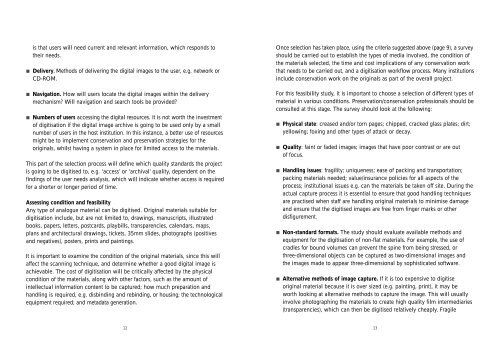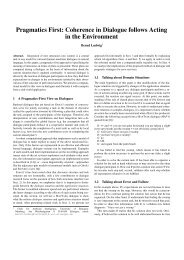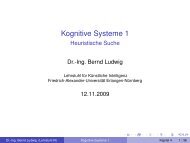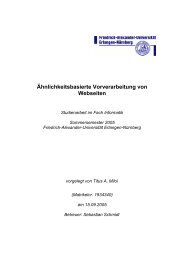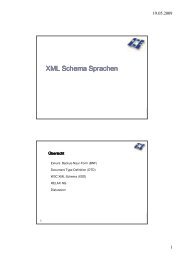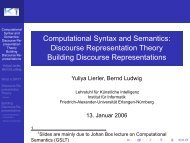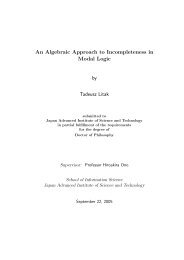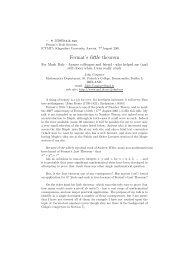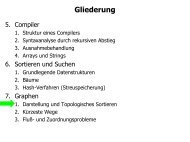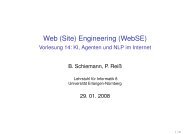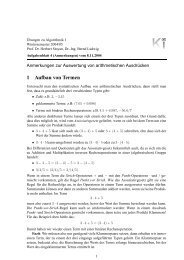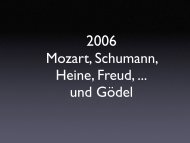Managing the Digitisation of Library, Archive and Museum Materials
Managing the Digitisation of Library, Archive and Museum Materials
Managing the Digitisation of Library, Archive and Museum Materials
Create successful ePaper yourself
Turn your PDF publications into a flip-book with our unique Google optimized e-Paper software.
is that users will need current <strong>and</strong> relevant information, which responds to<br />
<strong>the</strong>ir needs.<br />
■ Delivery. Methods <strong>of</strong> delivering <strong>the</strong> digital images to <strong>the</strong> user, e.g. network or<br />
CD-ROM.<br />
■ Navigation. How will users locate <strong>the</strong> digital images within <strong>the</strong> delivery<br />
mechanism? Will navigation <strong>and</strong> search tools be provided?<br />
■ Numbers <strong>of</strong> users accessing <strong>the</strong> digital resources. It is not worth <strong>the</strong> investment<br />
<strong>of</strong> digitisation if <strong>the</strong> digital image archive is going to be used only by a small<br />
number <strong>of</strong> users in <strong>the</strong> host institution. In this instance, a better use <strong>of</strong> resources<br />
might be to implement conservation <strong>and</strong> preservation strategies for <strong>the</strong><br />
originals, whilst having a system in place for limited access to <strong>the</strong> materials.<br />
This part <strong>of</strong> <strong>the</strong> selection process will define which quality st<strong>and</strong>ards <strong>the</strong> project<br />
is going to be digitised to, e.g. ‘access’ or ‘archival’ quality, dependent on <strong>the</strong><br />
findings <strong>of</strong> <strong>the</strong> user needs analysis, which will indicate whe<strong>the</strong>r access is required<br />
for a shorter or longer period <strong>of</strong> time.<br />
Assessing condition <strong>and</strong> feasibility<br />
Any type <strong>of</strong> analogue material can be digitised. Original materials suitable for<br />
digitisation include, but are not limited to, drawings, manuscripts, illustrated<br />
books, papers, letters, postcards, playbills, transparencies, calendars, maps,<br />
plans <strong>and</strong> architectural drawings, tickets, 35mm slides, photographs (positives<br />
<strong>and</strong> negatives), posters, prints <strong>and</strong> paintings.<br />
It is important to examine <strong>the</strong> condition <strong>of</strong> <strong>the</strong> original materials, since this will<br />
affect <strong>the</strong> scanning technique, <strong>and</strong> determine whe<strong>the</strong>r a good digital image is<br />
achievable. The cost <strong>of</strong> digitisation will be critically affected by <strong>the</strong> physical<br />
condition <strong>of</strong> <strong>the</strong> materials, along with o<strong>the</strong>r factors, such as <strong>the</strong> amount <strong>of</strong><br />
intellectual information content to be captured; how much preparation <strong>and</strong><br />
h<strong>and</strong>ling is required, e.g. disbinding <strong>and</strong> rebinding, or housing; <strong>the</strong> technological<br />
equipment required; <strong>and</strong> metadata generation.<br />
Once selection has taken place, using <strong>the</strong> criteria suggested above (page 9), a survey<br />
should be carried out to establish <strong>the</strong> types <strong>of</strong> media involved, <strong>the</strong> condition <strong>of</strong><br />
<strong>the</strong> materials selected, <strong>the</strong> time <strong>and</strong> cost implications <strong>of</strong> any conservation work<br />
that needs to be carried out, <strong>and</strong> a digitisation workflow process. Many institutions<br />
include conservation work on <strong>the</strong> originals as part <strong>of</strong> <strong>the</strong> overall project.<br />
For this feasibility study, it is important to choose a selection <strong>of</strong> different types <strong>of</strong><br />
material in various conditions. Preservation/conservation pr<strong>of</strong>essionals should be<br />
consulted at this stage. The survey should look at <strong>the</strong> following:<br />
■ Physical state: creased <strong>and</strong>/or torn pages; chipped, cracked glass plates; dirt;<br />
yellowing; foxing <strong>and</strong> o<strong>the</strong>r types <strong>of</strong> attack or decay.<br />
■ Quality: faint or faded images; images that have poor contrast or are out<br />
<strong>of</strong> focus.<br />
■ H<strong>and</strong>ling issues: fragility; uniqueness; ease <strong>of</strong> packing <strong>and</strong> transportation;<br />
packing materials needed; value/insurance policies for all aspects <strong>of</strong> <strong>the</strong><br />
process; institutional issues e.g. can <strong>the</strong> materials be taken <strong>of</strong>f site. During <strong>the</strong><br />
actual capture process it is essential to ensure that good h<strong>and</strong>ling techniques<br />
are practised when staff are h<strong>and</strong>ling original materials to minimise damage<br />
<strong>and</strong> ensure that <strong>the</strong> digitised images are free from finger marks or o<strong>the</strong>r<br />
disfigurement.<br />
■ Non-st<strong>and</strong>ard formats. The study should evaluate available methods <strong>and</strong><br />
equipment for <strong>the</strong> digitisation <strong>of</strong> non-flat materials. For example, <strong>the</strong> use <strong>of</strong><br />
cradles for bound volumes can prevent <strong>the</strong> spine from being stressed, or<br />
three-dimensional objects can be captured as two-dimensional images <strong>and</strong><br />
<strong>the</strong> images made to appear three-dimensional by sophisticated s<strong>of</strong>tware.<br />
■ Alternative methods <strong>of</strong> image capture. If it is too expensive to digitise<br />
original material because it is over sized (e.g. painting, print), it may be<br />
worth looking at alternative methods to capture <strong>the</strong> image. This will usually<br />
involve photographing <strong>the</strong> materials to create high quality film intermediaries<br />
(transparencies), which can <strong>the</strong>n be digitised relatively cheaply. Fragile<br />
12<br />
13


